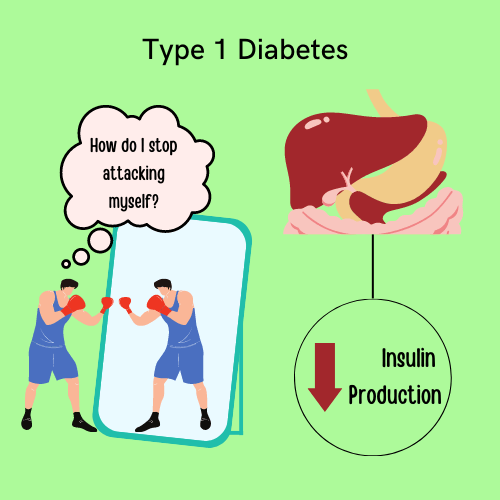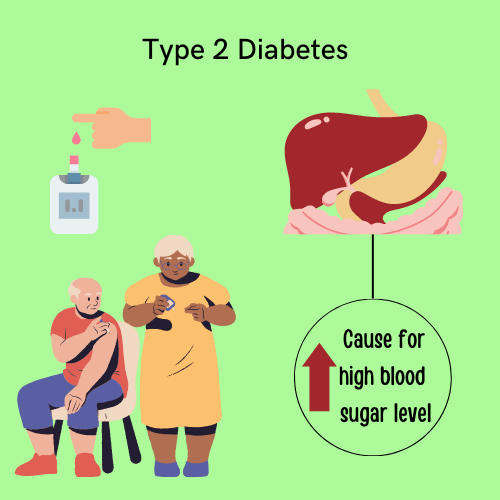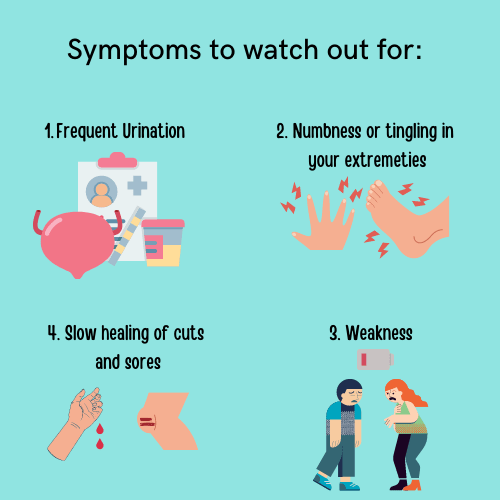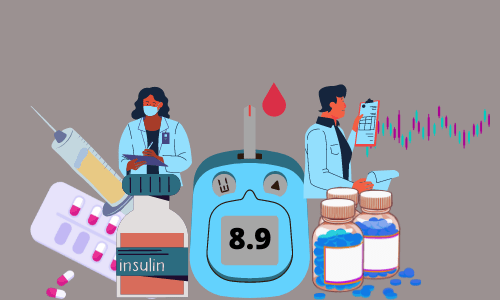Diabetes is one of the most widely discussed diseases of the 21st century. Since almost everyone has known a diabetic at some point in their lives , words like “blood sugar” and “insulin” have now become common dinner conversation.
Let us dive into all that it entails.
Whenever you eat carbohydrates (such as bread, pasta and rice) your body breaks them down into the building block, glucose. This glucose is used by your body for metabolic activities and energy. For this glucose to enter your cells and get metabolized, it needs a little help from a hormone called Insulin, which is secreted by your pancreas into the bloodstream.
A problem with the body’s insulin results in accumulation of glucose in your bloodstream, which causes diabetes. Diabetes is caused in one of two scenarios: your pancreas cannot produce enough insulin, or your body cannot effectively use the insulin that is produced. There exist 2 types of diabetes – Type 1, and Type 2.

Type 1 is an auto-immune disease, i.e., it occurs when your body’s immune system attacks itself. It is caused by deficient insulin production, and requires daily administration of insulin. It is usually diagnosed in children and young adults, so much so that it was originally known as ‘juvenile diabetes’, but can develop at any age.

Type 2 diabetes can have either of the two causes for high blood sugar level. It is the more common type and usually occurs in middle-aged or older people. However, nowadays, the incidence of Type 2 appears to be increasing in children and younger people.
Why is this happening?
Diabetes is also termed as a “lifestyle disease”, which implies that risk factors of the disease are embedded in our day-to-day habits. With an increase in inflation, technology, and “hustle-culture”, there is an increased sedentary lifestyle and consumption of fat-rich, processed foods along with a lack of sufficient sleep and physical activity. An increase in alcohol intake and smoking is also contributing to high numbers of Type 2. Of course, there are always risk factors like your genetics, age, ethnicity, heart disease, etc. which cannot be helped. But a healthy diet, exercise, and the right amount of sleep are good first steps to delay the onset of diabetes.
In addition to these well-known factors, a study published in Nature by Stanford scientist Michael Snyder recently found an interesting correlation between diabetes and the microbiome of humans. His team of researchers followed 106 people for nearly four years, profiling their microbiomes from nasal swabs, stool samples, and blood, every three months. The volunteers also provided samples when they were ill and, at their will, during stressful events such as job changes, weight gain, travel, or exposure to environmental elements that could affect health. Some similarities were found in the microbiome of people with insulin resistance – they tended to have different microbes, which caused their immune cells to act in different ways compared to people who are sensitive to insulin. So, when those who are insulin-resistant or pre-diabetic fall sick, their immune responses are often weaker than those who are not. (A condition when a person has a slightly high value of blood glucose, but not high enough for it to be diagnosed as diabetes, is known as a ‘pre-diabetic condition’. People with such a predisposition to diabetes should be especially careful, and get tested frequently.)
Diabetes is a chronic disease, which means it lasts long-term and can be managed, but not cured. The earlier it is diagnosed, the better it can be controlled. So, some of the symptoms to watch out for are frequent urination, sudden weight loss, excessive hunger or thirst, weakness, numbness or tingling in your extremities, and slow healing of cuts or sores. Diabetes is diagnosed through a blood test which determines the level of glucose in your blood sample. So, when you notice one or more of the above symptoms together, it might be a good idea to get your blood glucose levels tested. Diabetes is currently treated by trying to keep your blood glucose levels as close to normal as possible through prescribed medicines or direct insulin injection.

Researchers in life sciences, pharmaceutical companies, and the medical community worldwide are ardently working on identifying therapeutic targets that are capable of reducing abnormalities associated with diabetes, including the insulin resistance and insulin deficiency.
Currently, the numbers of this disease are rising at an alarming rate.

As of 2020, the prevalence of diabetes is 8.9% (1 in 6 people) in the Indian population, according to the International Diabetes federation. 11.3% of the American population has been diagnosed with diabetes, and a whopping 463 million people worldwide.
Since the majority of people are not diagnosed early, increased education (like articles on The Science Paradox!) about the symptoms of diabetes may help people seek out health care providers early in the disease progression, and to learn how changes in their lifestyle activities can help them reduce their risk of developing diabetes.
References:
- Diabetes overview https://www.who.int/news-room/fact-sheets/detail/diabetes
- Longitudinal multi-omics of host–microbe dynamics in prediabetes, Zhou, W., Sailani, M.R., Contrepois, K. et al. Longitudinal multi-omics of host–microbe dynamics in prediabetes. Nature 569, 663–671 (2019). https://doi.org/10.1038/s41586-019-1236-x
- Diabetes in India https://www.who.int/india/Campaigns/and/events/world-diabetes-day
- Diabetes’ correlation with lifestyle habits https://www.ncbi.nlm.nih.gov/pmc/articles/PMC5792082/
- Diabetes symptoms https://www.cdc.gov/diabetes/basics/symptoms.html
. . .
Writer
Sharvari Kelkar
Editor
Kadambari Vijay Sai
Illustrator
Urja Kuber

